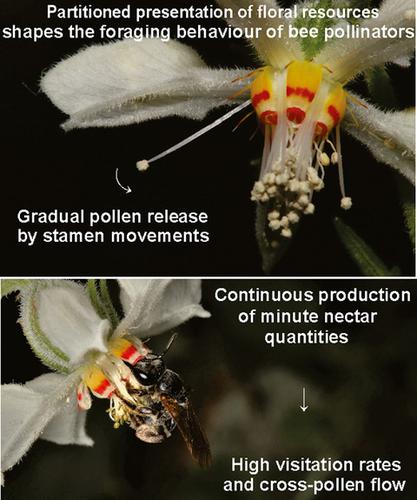当前位置:
X-MOL 学术
›
Plant Biol.
›
论文详情
Our official English website, www.x-mol.net, welcomes your
feedback! (Note: you will need to create a separate account there.)
Specialised protagonists in a plant-pollinator interaction: the pollination of Blumenbachia insignis (Loasaceae).
Plant Biology ( IF 4.2 ) Pub Date : 2019-12-10 , DOI: 10.1111/plb.13072 S Siriani-Oliveira 1 , I Cerceau 1 , C Schlindwein 2
Plant Biology ( IF 4.2 ) Pub Date : 2019-12-10 , DOI: 10.1111/plb.13072 S Siriani-Oliveira 1 , I Cerceau 1 , C Schlindwein 2
Affiliation

|
Analyses of resource presentation, floral morphology and pollinator behaviour are essential for understanding specialised plant-pollinator systems. We investigated whether foraging by individual bee pollinators fits the floral morphology and functioning of Blumenbachia insignis, whose flowers are characterised by a nectar scale-staminode complex and pollen release by thigmonastic stamen movements. We described pollen and nectar presentation, analysed the breeding system and the foraging strategy of bee pollinators. We determined the nectar production pattern and documented variations in the longevity of floral phases and stigmatic pollen loads of pollinator-visited and unvisited flowers. Bicolletes indigoticus (Colletidae) was the sole pollinator with females revisiting flowers in staminate and pistillate phases at short intervals, guaranteeing cross-pollen flow. Nectar stored in the nectar scale-staminode complex had a high sugar concentration and was produced continuously in minute amounts (~0.09 μl·h-1 ). Pushing the scales outward, bees took up nectar, triggering stamen movements and accelerating pollen presentation. Experimental simulation of this nectar uptake increased the number of moved stamens per hour by a factor of four. Flowers visited by pollinators received six-fold more pollen on the stigma than unvisited flowers, had shortened staminate and pistillate phases and increased fruit and seed set. Flower handling and foraging by Bicolletes indigoticus were consonant with the complex flower morphology and functioning of Blumenbachia insignis. Continuous nectar production in minute quantities but at high sugar concentration influences the pollen foraging of the bees. Partitioning of resources lead to absolute flower fidelity and stereotyped foraging behaviour by the sole effective oligolectic bee pollinator.
中文翻译:

植物-授粉媒介相互作用中的专业主角:凤尾兰(Loasaceae)的授粉。
资源介绍,花卉形态和授粉媒介行为的分析对于理解专业的植物授粉系统至关重要。我们调查了单个蜜蜂授粉者觅食是否适合花形形态和功能的Blumenbachia insignis,其花朵的特征是花蜜鳞茎-退化雄激素复合体和花粉的雄蕊雄蕊运动释放花粉。我们描述了花粉和花蜜的表现,分析了蜜蜂授粉媒介的繁殖系统和觅食策略。我们确定了花蜜的生产模式,并记录了花粉期的长短以及授粉者访问和未访问的花的花粉负载量的变化。雌性双翅目昆虫(Colletidae)是唯一的授粉媒介,雌性在短时期内在雄性和雌性阶段重新访花,保证交叉花粉流动。存储在花蜜鳞片-氨基甲酸酯复合物中的花蜜具有高的糖浓度并且以微量(〜0.09μl·h-1)连续地产生。蜜蜂将鳞片向外推,吸收了花蜜,触发了雄蕊运动并加速了花粉的出现。对这种花蜜摄取的实验模拟使每小时移动的雄蕊数量增加了四倍。授粉者访问的花在柱头上的花粉比未看过的花多六倍,缩短了雄蕊和雌蕊相的时间,并增加了果实和种子的结实率。Bicolletes indigoticus的花朵处理和觅食与徽蓝假花的复杂花朵形态和功能是一致的。少量连续花蜜生产但糖浓度高会影响蜜蜂的花粉觅食。资源分配导致唯一的有效低聚蜂授粉者实现绝对的花朵保真度和定型的觅食行为。
更新日期:2019-12-10
中文翻译:

植物-授粉媒介相互作用中的专业主角:凤尾兰(Loasaceae)的授粉。
资源介绍,花卉形态和授粉媒介行为的分析对于理解专业的植物授粉系统至关重要。我们调查了单个蜜蜂授粉者觅食是否适合花形形态和功能的Blumenbachia insignis,其花朵的特征是花蜜鳞茎-退化雄激素复合体和花粉的雄蕊雄蕊运动释放花粉。我们描述了花粉和花蜜的表现,分析了蜜蜂授粉媒介的繁殖系统和觅食策略。我们确定了花蜜的生产模式,并记录了花粉期的长短以及授粉者访问和未访问的花的花粉负载量的变化。雌性双翅目昆虫(Colletidae)是唯一的授粉媒介,雌性在短时期内在雄性和雌性阶段重新访花,保证交叉花粉流动。存储在花蜜鳞片-氨基甲酸酯复合物中的花蜜具有高的糖浓度并且以微量(〜0.09μl·h-1)连续地产生。蜜蜂将鳞片向外推,吸收了花蜜,触发了雄蕊运动并加速了花粉的出现。对这种花蜜摄取的实验模拟使每小时移动的雄蕊数量增加了四倍。授粉者访问的花在柱头上的花粉比未看过的花多六倍,缩短了雄蕊和雌蕊相的时间,并增加了果实和种子的结实率。Bicolletes indigoticus的花朵处理和觅食与徽蓝假花的复杂花朵形态和功能是一致的。少量连续花蜜生产但糖浓度高会影响蜜蜂的花粉觅食。资源分配导致唯一的有效低聚蜂授粉者实现绝对的花朵保真度和定型的觅食行为。











































 京公网安备 11010802027423号
京公网安备 11010802027423号